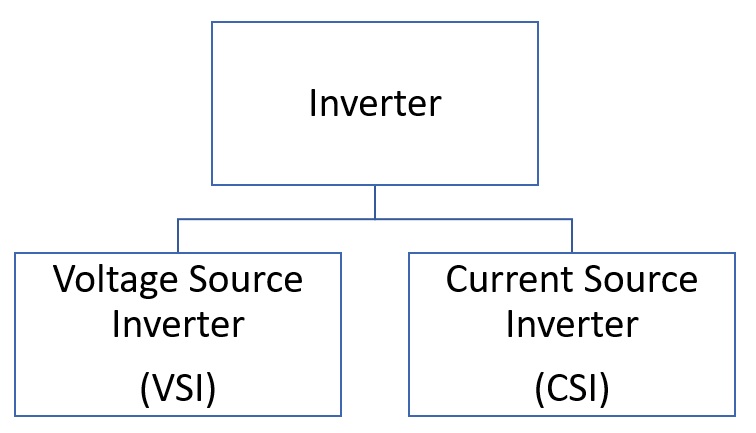An inverter is a device which converts DC power into AC power at desired output voltage and frequency.
The DC power input to the inverter is obtained from an existing power supply source or from a rotating alternator through a rectifier or a battery, fuel cell, photovoltaic array or magnetohydrodynamic (MHD) generator. For household application, inverter converts the DC power available for battery into 240 V AC.
Types of Inverter:
Inverters can be broadly classified into two types: Voltage Source Inverter (VSI) and Current Source Inverter (CSI). This classification is based on the input source i.e. whether the input source is voltage source or current source.

A voltage fed or voltage source inverter (VSI) is one in which the DC source has small or negligible impedance. In other words, the VSI has stiff DC voltage source at its input terminals.
A current Source Inverter (CSI) is fed with adjustable current from a DC source of high impedance i.e. from a stiff DC current source. In a CSI fed with stiff current source, output current waves are not affected by the load.
In VSIs using thyristors, some type of forced commutation is required; however, load commutation is possible only if the load is underdamped. In VSIs using GTOs, switching off is achieved by applying negative gate current pulse. VSIs using transistors, like BJTs, PMOSFETs, IGBTs or SITs, can be turned off by the control of their base current. Switching off of the devices with the help of their gate or base current is called Self-commutation. So, the self-commutated inverters using GTOs and transistors do not require additional commutation circuitry as needed in thyristor-based inverters. This reduces the complexity and cost of the self-commutated inverter circuits and at the same time, enhances the reliability of their operation.
From the view point of connections of semiconductor devices, inverters are classified as below:
- Bridge Inverters
- Series Inverters
- Parallel Inverters
Bridge Inverters are one in which semiconducting devices are connected to form a bridge. This type can further be classified into Single Phase Bridge Inverter and Three Phase Bridge Inverter.
In series Inverter, the commutating devices are permanently connected in series with load. The series circuit so formed in underdamped in nature. Whereas in parallel type, a capacitor is connected in parallel with the load via a transformer.
Applications:
The main function of an inverters is to convert DC power into AC power. For house hold application, it converts the DC power from battery or solar panel into AC power which in turn is utilized for the functioning of different household appliances.
Some industrial applications of inverter are for adjustable speed AC drives, Induction Heating, Stand by Air Craft power Supplies, UPS (Uninterruptible Power Supplies) for computers, HVDC transmission line etc.
Please what’s your name? I want to add it to my references
You can add the website link as reference.